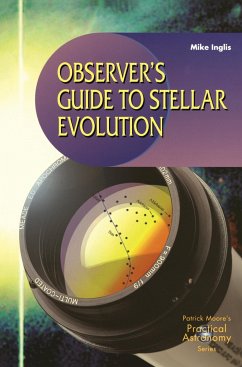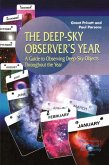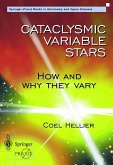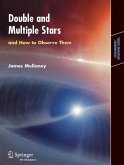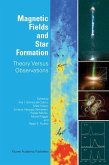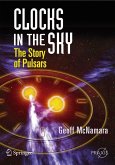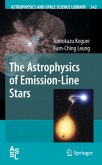- Broschiertes Buch
- Merkliste
- Auf die Merkliste
- Bewerten Bewerten
- Teilen
- Produkt teilen
- Produkterinnerung
- Produkterinnerung
Stellar evolution - the birth, development and death of stars - is central
to our current understanding of astronomy. This area of astrophysics is
often portrayed as being difficult and mathematical, but Mike Inglis
brings it to life in a unique way, combining a step-by-step introduction
with suggestions for making practical observations of stars at different
stages in their evolution. Every amateur astronomer - regardless of their
current level of knowledge - will find this book fascinating and
informative.
Andere Kunden interessierten sich auch für
![The Deep-Sky Observer¿s Year The Deep-Sky Observer¿s Year]() Paul ParsonsThe Deep-Sky Observer¿s Year35,99 €
Paul ParsonsThe Deep-Sky Observer¿s Year35,99 €![Cataclysmic Variable Stars - How and Why they Vary Cataclysmic Variable Stars - How and Why they Vary]() Coel HellierCataclysmic Variable Stars - How and Why they Vary49,99 €
Coel HellierCataclysmic Variable Stars - How and Why they Vary49,99 €![Double & Multiple Stars, and How to Observe Them Double & Multiple Stars, and How to Observe Them]() J. MullaneyDouble & Multiple Stars, and How to Observe Them32,99 €
J. MullaneyDouble & Multiple Stars, and How to Observe Them32,99 €![Magnetic Fields and Star Formation Magnetic Fields and Star Formation]() Ana I. Gómez de Castro / Mark Heyer / Enrique Vázquez-Semadeni / Rafael Rebolo / Michel Tagger / Ralph E. Pudritz (eds.)Magnetic Fields and Star Formation115,99 €
Ana I. Gómez de Castro / Mark Heyer / Enrique Vázquez-Semadeni / Rafael Rebolo / Michel Tagger / Ralph E. Pudritz (eds.)Magnetic Fields and Star Formation115,99 €![Clocks in the Sky Clocks in the Sky]() Geoff McNamaraClocks in the Sky23,99 €
Geoff McNamaraClocks in the Sky23,99 €![David Levy's Guide Variable Stars David Levy's Guide Variable Stars]() David H. LevyDavid Levy's Guide Variable Stars50,99 €
David H. LevyDavid Levy's Guide Variable Stars50,99 €![The Astrophysics of Emission-Line Stars The Astrophysics of Emission-Line Stars]() Tomokazu KogureThe Astrophysics of Emission-Line Stars149,99 €
Tomokazu KogureThe Astrophysics of Emission-Line Stars149,99 €-
-
-
Stellar evolution - the birth, development and death of stars - is central
to our current understanding of astronomy. This area of astrophysics is
often portrayed as being difficult and mathematical, but Mike Inglis
brings it to life in a unique way, combining a step-by-step introduction
with suggestions for making practical observations of stars at different
stages in their evolution. Every amateur astronomer - regardless of their
current level of knowledge - will find this book fascinating and
informative.
Hinweis: Dieser Artikel kann nur an eine deutsche Lieferadresse ausgeliefert werden.
to our current understanding of astronomy. This area of astrophysics is
often portrayed as being difficult and mathematical, but Mike Inglis
brings it to life in a unique way, combining a step-by-step introduction
with suggestions for making practical observations of stars at different
stages in their evolution. Every amateur astronomer - regardless of their
current level of knowledge - will find this book fascinating and
informative.
Hinweis: Dieser Artikel kann nur an eine deutsche Lieferadresse ausgeliefert werden.
Produktdetails
- Produktdetails
- The Patrick Moore Practical Astronomy Series
- Verlag: Springer / Springer London / Springer, Berlin
- Artikelnr. des Verlages: 978-1-85233-465-9
- Softcover reprint of the original 1st ed. 2003
- Seitenzahl: 260
- Erscheinungstermin: 6. November 2002
- Englisch
- Abmessung: 235mm x 155mm x 15mm
- Gewicht: 498g
- ISBN-13: 9781852334659
- ISBN-10: 1852334657
- Artikelnr.: 11159501
- Herstellerkennzeichnung
- Springer-Verlag GmbH
- Tiergartenstr. 17
- 69121 Heidelberg
- ProductSafety@springernature.com
- The Patrick Moore Practical Astronomy Series
- Verlag: Springer / Springer London / Springer, Berlin
- Artikelnr. des Verlages: 978-1-85233-465-9
- Softcover reprint of the original 1st ed. 2003
- Seitenzahl: 260
- Erscheinungstermin: 6. November 2002
- Englisch
- Abmessung: 235mm x 155mm x 15mm
- Gewicht: 498g
- ISBN-13: 9781852334659
- ISBN-10: 1852334657
- Artikelnr.: 11159501
- Herstellerkennzeichnung
- Springer-Verlag GmbH
- Tiergartenstr. 17
- 69121 Heidelberg
- ProductSafety@springernature.com
Mike Inglis, Princeton University, Lawrenceville, NJ, USA
A Brief Introduction.- 1 Stellar Evolution - The Basics.- 1.1 Distance to the Stars.- 1.2 The Nearest Stars.- 1.3 The Brightness and Luminosity of Stars.- 1.4 The Magnitudes of Stars.- 1.5 The Brightest Stars.- 1.6 The Colour of Stars.- 1.7 The Size and Mass of Stars.- 1.8 The Biggest Stars.- 1.9 The Constituents of Stars.- 1.10 The Spectra of Stars.- 1.11 Stellar Classification.- 1.12 The Hertzsprung-Russell Diagram.- 1.13 The H-R Diagram and a Star's Radius.- 1.14 The H-R Diagram and a Star's Luminosity.- 1.15 The H-R Diagram and a Star's Mass.- 2 Beginnings - Star Birth.- 2.1 Introduction.- 2.2 The Interstellar Medium.- 2.3 Nebulae.- 2.4 Molecular Clouds.- 2.5 Protostars.- 2.6 Pre-Main Sequence Evolution.- 2.7 Mass Loss and Mass Gain.- 2.8 Star Clusters.- 2.9 Stellar Associations and Streams.- 2.10 Star Formation Triggers.- 3 The Main Sequence and Beyond.- 3.1 Introduction.- 3.2 Our Nearest Star - The Sun.- 3.3 From the Surface to the Core.- 3.4 The Proton-Proton Chain.- 3.5 The Flow of Energy from the Core to the Surface.- 3.6 Main Sequence Lifetimes.- 3.7 Towards the Red Giant.- 3.8 Helium Burning and the Helium Flash.- 3.9 Red Giants, Star Clusters and the H-R Diagram.- 3.10 Post-Main Sequence Star Clusters: The Globular Clusters.- 3.11 Stars That Pulsate.- 3.12 Cepheid Variables and the Period-Luminosity Relationship.- 3.13 Cepheid Variables: Temperature and Mass.- 3.14 RR Lyrae and Long-Period Variable Stars.- 4 The End Point - Star Death.- 4.1 Introduction.- 4.2 The Asymptotic Giant Branch.- 4.3 Dredge-Ups.- 4.4 Mass Loss and Stellar Winds.- 4.5 Infrared Stars.- 4.6 The End of an AGB Star's Life.- 4.7 Planetary Nebulae.- 4.8 White Dwarf Stars.- 4.9 Electron Degeneracy and White Dwarfs.- 4.10 The Chandrasekhar Limit.- 4.11 WhiteDwarf Evolution.- 4.12 White Dwarf Origins.- 4.13 High-Mass Stars: Nuclear Burning and an Onion.- 4.14 Iron, Supernovae and the Formation of the Elements.- 4.15 The Supernova Remnant.- 4.16 A Final Note on Supernovae.- 4.17 Neutron Stars, Pulsars and Black Holes.- 4.18 From Beginning to End.- Appendix 1 Degeneracy.- Appendix 2 Books, Magazines and Organizations.- Appendix 3 The Greek Alphabet.- Appendix 4 Colour Photographs.- Object Index.
A Brief Introduction.- 1 Stellar Evolution - The Basics.- 1.1 Distance to the Stars.- 1.2 The Nearest Stars.- 1.3 The Brightness and Luminosity of Stars.- 1.4 The Magnitudes of Stars.- 1.5 The Brightest Stars.- 1.6 The Colour of Stars.- 1.7 The Size and Mass of Stars.- 1.8 The Biggest Stars.- 1.9 The Constituents of Stars.- 1.10 The Spectra of Stars.- 1.11 Stellar Classification.- 1.12 The Hertzsprung-Russell Diagram.- 1.13 The H-R Diagram and a Star's Radius.- 1.14 The H-R Diagram and a Star's Luminosity.- 1.15 The H-R Diagram and a Star's Mass.- 2 Beginnings - Star Birth.- 2.1 Introduction.- 2.2 The Interstellar Medium.- 2.3 Nebulae.- 2.4 Molecular Clouds.- 2.5 Protostars.- 2.6 Pre-Main Sequence Evolution.- 2.7 Mass Loss and Mass Gain.- 2.8 Star Clusters.- 2.9 Stellar Associations and Streams.- 2.10 Star Formation Triggers.- 3 The Main Sequence and Beyond.- 3.1 Introduction.- 3.2 Our Nearest Star - The Sun.- 3.3 From the Surface to the Core.- 3.4 The Proton-Proton Chain.- 3.5 The Flow of Energy from the Core to the Surface.- 3.6 Main Sequence Lifetimes.- 3.7 Towards the Red Giant.- 3.8 Helium Burning and the Helium Flash.- 3.9 Red Giants, Star Clusters and the H-R Diagram.- 3.10 Post-Main Sequence Star Clusters: The Globular Clusters.- 3.11 Stars That Pulsate.- 3.12 Cepheid Variables and the Period-Luminosity Relationship.- 3.13 Cepheid Variables: Temperature and Mass.- 3.14 RR Lyrae and Long-Period Variable Stars.- 4 The End Point - Star Death.- 4.1 Introduction.- 4.2 The Asymptotic Giant Branch.- 4.3 Dredge-Ups.- 4.4 Mass Loss and Stellar Winds.- 4.5 Infrared Stars.- 4.6 The End of an AGB Star's Life.- 4.7 Planetary Nebulae.- 4.8 White Dwarf Stars.- 4.9 Electron Degeneracy and White Dwarfs.- 4.10 The Chandrasekhar Limit.- 4.11 WhiteDwarf Evolution.- 4.12 White Dwarf Origins.- 4.13 High-Mass Stars: Nuclear Burning and an Onion.- 4.14 Iron, Supernovae and the Formation of the Elements.- 4.15 The Supernova Remnant.- 4.16 A Final Note on Supernovae.- 4.17 Neutron Stars, Pulsars and Black Holes.- 4.18 From Beginning to End.- Appendix 1 Degeneracy.- Appendix 2 Books, Magazines and Organizations.- Appendix 3 The Greek Alphabet.- Appendix 4 Colour Photographs.- Object Index.

